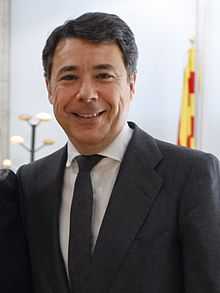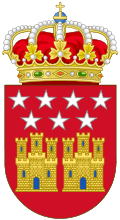President of the Community of Madrid
| President of the Community of Madrid
Presidente de la Comunidad de Madrid | |
|---|---|
|
Coat of arms of the Community of Madrid | |
| Style | Excelentisimo/a señor/a (His Excelency) |
| Nominator | Madrid Assembly |
| Term length | Four years |
| Inaugural holder | Joaquín Leguina |
| Formation | 1983 |
| Website | www.madrid.org |
The President of the Community of Madrid is the highest-ranking officer of the Autonomous Community of Madrid and the head of the Executive Branch. The office is currently held by Ignacio González González of the People's Party.
Origins and election
_01.jpg)
In the process of the democracy restoration in Spain between 1975–1978, the nationalist and regionalist parties pressed to grant home rule to parts of Spain. Finally, the Constitution stated that any province or group of provinces could form an autonomous community and thus be granted partial home rule. The Autonomous Community of Madrid (Spanish Comunidad Autónoma de Madrid) was created in 1982, and since then regional elections are held every 4 years.
Unlike those of the US states, the citizens of the Autonomous Communities of Spain don't elect a person for presidency of their community: they elect the regional legislature, and that legislature elects the regional President. This system usually assures the government more stability because a candidate needs a majority (that is supposed to be loyal to him/her during the whole term) to be elected, but has a significant drawback: a party can win the election (be the top-voted party) and still be denied the right to form the government (have a majority). This situation, though infrequent in nationwide elections, often happens in local/regional legislatures throughout Spain: the most usual coalition is between the Socialist Party (PSOE) and the United Left (IU).
In Madrid, such a coalition was formed in the 2nd term, in which the incumbent Socialist Joaquín Leguina won the election without a majority,[1] once more in the 3rd term, allowing him to remain in office even after having lost the election to the People's Party (PP), and once more in the 6th term, by the PSOE candidate Rafael Simancas. However, this last coalition ultimately failed due to the dissidence of two PSOE Assembly Members, which denounced the pact with IU as being too wide and unrepresentative of the people's will due to the planned power balance. Elections were repeated after a few weeks and Partido Popular won, then by absolute majority.
Since then, Popular Party victories by absolute majority were repeated in 2007 and 2011's regional elections. After resignation of President Esperanza Aguirre due to personal matters in late 2012, deputy president Ignacio González González hold the post.
List of Presidents of the Autonomous Community of Madrid
| Picture | President | Political Party | Assembly term | Assembly composition[2] |
|---|---|---|---|---|
| Joaquín Leguina | PSOE | 1st (1983–87) | PSOE: 51; AP-PDP-UL: 34; IU: 9 | |
| 2nd (1987–91) | PSOE: 40; AP: 32; CDS: 17; IU:7 | |||
| 3rd (1991–95) | PP: 47; PSOE: 41; IU:13 | |||
 |
Alberto Ruiz-Gallardón | PP | 4th (1995–99) | PP: 54; PSOE: 32; IU: 17 |
| 5th (1999–2003) | PP: 55; PSOE: 39; IU: 8 | |||
| same as caretaker President | 6th (May–October 2003) | PP: 55; PSOE: 47 (45); IU: 9; Ind: 0 (2)[3] | ||
.jpg) |
Esperanza Aguirre | 7th (2003–07) | PP: 57; PSOE: 45; IU: 9 | |
| 8th (2007–11) | PP: 67; PSOE: 42; IU: 11 | |||
| 9th (2011–12) | PP: 72; PSOE: 36; IU: 13; UPyD: 8 | |||
 |
Ignacio González González | PP | 9th (2012-) |
The 6th term scandal
In the May 2003 election, the ruling People's Party switched leadership: incumbent President Alberto Ruiz-Gallardón aimed for the office of Mayor of Madrid, which he successfully obtained with a safe majority, while the regional list was headed by Senator and ex-Minister Esperanza Aguirre. The election was strongly contested and in the end the PP won but fell some 25,000 votes short of a majority, with 55 out of 111 seats. The other two forces in the newly elected Assembly, the PSOE (47 seats) and IU (9), both leaning left, started negotiations and in the end agreed to a coalition government, which included the election of a favorable President of the Assembly (i.e. Speaker) and Bureau. As part of the deal, Socialists would control the majority of the government, but a disproportionate amount of the budget would be under the responsibility of IU regional ministers. This sparked criticism from some sectors in the Socialist party, but then-leader Rafael Simancas dismissed them as moot, saying "it was time for a government of the left in Madrid".
However two PSOE deputies refused to back the planned pact with IU with the result that no President could be elected. Fresh elections were then held where the PP won an absolute majority.
Notes and references
- ↑ In fact, even the PSOE-IU coalition was in the minority (47 seats) against the centre-right parties PP and CDS (49), which could not reach an agreement to rule. Once they did, a situation similar to the 6th term scandal arose, depriving those parties of the majority and allowing President Leguina to continue his minority government.
- ↑ Majority party in bold, government coalition partners in italics
- ↑ See 6th term scandal
